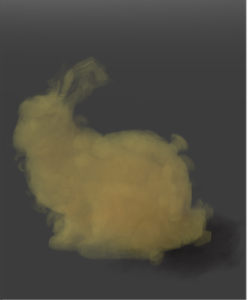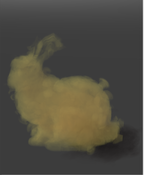Information
- Publication Type: Bachelor Thesis
- Workgroup(s)/Project(s):
- Date: October 2014
- First Supervisor:
- Keywords: fluid simulation, fluid control
Abstract
This thesis introduces a novel approach to control smoke towards a target density distribution with minimal force impact to reduce unnatural behavior and unconvincing visual results. The first part consists of an introduction to fluid simulations and fluid control followed by an exploration of previous research in the field of Computational fluid dynamics, especially in Computer Graphics. After that, the Navier-Stokes equations are introduced and a short overview on how to solve them is given. The last part describes our approach to controlling smoke based on biased diffusion and long-range force and shows the results of this research. Based on a criterion, which has emerged from the numerical solution of diffusion, the algorithm decides whether to apply forces or use diffusion to distribute the smoke resulting in a great reduction of forces applied to the smoke. Results show that the smoke reaches the target density faster and the motion is much less furious, which contributes to more natural results. Our algorithm is implemented in the open source animation software Blender and gives the artist access to smoke control parameters.Additional Files and Images
Weblinks
No further information available.BibTeX
@bachelorsthesis{Fuerst_2014_BSc,
title = "Control of Newtonian Fluids With Minimum Force Impact Using
the Navier-Stokes Equations",
author = "Patrick F\"{u}rst",
year = "2014",
abstract = "This thesis introduces a novel approach to control smoke
towards a target density distribution with minimal force
impact to reduce unnatural behavior and unconvincing visual
results. The first part consists of an introduction to fluid
simulations and fluid control followed by an exploration of
previous research in the field of Computational fluid
dynamics, especially in Computer Graphics. After that, the
Navier-Stokes equations are introduced and a short overview
on how to solve them is given. The last part describes our
approach to controlling smoke based on biased diffusion and
long-range force and shows the results of this research.
Based on a criterion, which has emerged from the numerical
solution of diffusion, the algorithm decides whether to
apply forces or use diffusion to distribute the smoke
resulting in a great reduction of forces applied to the
smoke. Results show that the smoke reaches the target
density faster and the motion is much less furious, which
contributes to more natural results. Our algorithm is
implemented in the open source animation software Blender
and gives the artist access to smoke control parameters.",
month = oct,
address = "Favoritenstrasse 9-11/E193-02, A-1040 Vienna, Austria",
school = "Institute of Computer Graphics and Algorithms, Vienna
University of Technology ",
keywords = "fluid simulation, fluid control",
URL = "https://www.cg.tuwien.ac.at/research/publications/2014/Fuerst_2014_BSc/",
}

 thesis
thesis

